Radon Facts
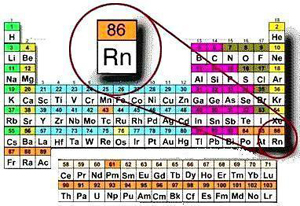
What is Radon?
Radon is radiation. There are no safe levels of radiation, so the higher your radon level, the greater your risk. Health experts recommend that you try to minimize your exposure to all forms of radiation including x-rays, nuclear radiation and solar radiation, but especially radon because of its ability to mutate cells within the human body.
Radon is element # 86 on the periodic chart of elements. It is a colorless, tasteless and odorless gas with a radioactive half-life of only 3.82 days. Radon is created when radium, element #88, breaks down through radioactive decay. Radium's half-life is 1622 years. The amount of radon in your home will be determined by the amount of radium present in the soil that surrounds your house. It also depends on the ease of entry and amount of negative pressure within the home.
How Radon Causes Cancer
All radioactive elements break down (radioactive decay) over time through a process measured in half-lives. As these elements break down, they actually create entirely new elements, each with its own specific half-life. Each time a new element is created, it releases more radiation. The faster this occurs, the more radiation is produced. As radon breaks down, it creates other radioactive elements called radon progeny or daughters - each with even shorter half-lives that break down again, again and again in half-lives from minutes to just fractions of a second.
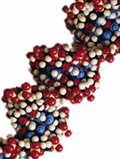 Each time an element breaks down, it explodes with radioactive energy strong enough to form a small crater on glass when observed through a microscope. If these explosions occur within the human body, for example while breathing, the radiation can be deposited on a cell, either killing it or forcing it to repair itself. Fortunately, cells often do an excellent job of repairing themselves but sometimes, the DNA structure within the cell changes. The mutated cell then begins to multiply and cancer begins to spread. The more cells that are exposed to radiation, the greater the risk of cell mutation.
Each time an element breaks down, it explodes with radioactive energy strong enough to form a small crater on glass when observed through a microscope. If these explosions occur within the human body, for example while breathing, the radiation can be deposited on a cell, either killing it or forcing it to repair itself. Fortunately, cells often do an excellent job of repairing themselves but sometimes, the DNA structure within the cell changes. The mutated cell then begins to multiply and cancer begins to spread. The more cells that are exposed to radiation, the greater the risk of cell mutation. Children's cells are still growing and changing rapidly so they are at the greatest risk as well as anyone who spends a great deal of time at home. Unfortunately, the human body does not produce symptoms or warning signs to alert us when being exposed to radiation. Radon causes cancer, but does not cause headaches, nausea or other feelings of ill health. Most people won't know they have cancer until they hear it from their doctor. The only way to know if your family is being exposed is to test.
How Is Radon Measured?
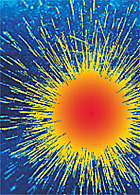 Radon is measured in pico-Curies per liter of air (pCi/L), named after Madame Curie.
Radon is measured in pico-Curies per liter of air (pCi/L), named after Madame Curie.1 pCi/L equals 2.2 radioactive explosions every minute in every liter of air. That doesn't sound like much until you consider the amount of air within a house. For example, a 1,000 square foot home with 4pCi/L will have about 2 million explosions occurring in that house every single minute of every day. If they made special eye glasses that would allow people to see those explosions as they occurred, there is no doubt that everyone with a radon problem would have it fixed!
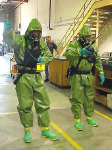 The half-life of radium is relatively stable at 1,622 years but the half-life of radon is only 3.82 days. Worse yet, is the half-life of radon decay products, which explode at even faster rates, repeatedly striking our cells with radiation. It is actually radon decay products that cause all the damage, not radon, but we still test for radon because it's easier to measure.
The half-life of radium is relatively stable at 1,622 years but the half-life of radon is only 3.82 days. Worse yet, is the half-life of radon decay products, which explode at even faster rates, repeatedly striking our cells with radiation. It is actually radon decay products that cause all the damage, not radon, but we still test for radon because it's easier to measure.You may have seen guys dressed up in radiation suits on T.V. carrying a Geiger counter. Every time a Geiger counter makes a "tick" sound, it represents one of those radioactive explosions and the closer they get to the source of the radiation, the more it ticks. In other words, "Stay Away!" Radon tests work in a similar way by counting the number of explosions over a period of time to determine the amount of radon in your home. So in reality, radon test kits simply tell us is how many of those radioactive explosions are occurring in our home every minute of every hour of every day.
Time Vs. Radon
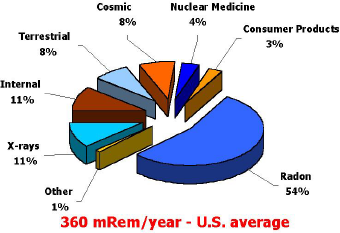 Time exposed multiplied by the amount of radiation, equals dose. So living in a house with 1 pCi/L for 5 years is the same radiation exposure as living in a house with 5 pCi/L for 1 year. Same amount of radiation exposure in both cases. Just like standing next to a nuclear power plant for 2 hours is twice as bad as standing there for 1 hour. So, either lower the amount of radon your family is exposed to or the amount of time exposed and it will immediately begin to effect your past exposure while also protecting your family in the future. Be sure to also test anywhere you or a family member spends a lot of time like at work, school, child care, etc.
Time exposed multiplied by the amount of radiation, equals dose. So living in a house with 1 pCi/L for 5 years is the same radiation exposure as living in a house with 5 pCi/L for 1 year. Same amount of radiation exposure in both cases. Just like standing next to a nuclear power plant for 2 hours is twice as bad as standing there for 1 hour. So, either lower the amount of radon your family is exposed to or the amount of time exposed and it will immediately begin to effect your past exposure while also protecting your family in the future. Be sure to also test anywhere you or a family member spends a lot of time like at work, school, child care, etc. If you are fortunate to have a home that measures between 1.3 pCi/L to 1.5 pCi/L then your home is considered average. Combine this with all other forms of radiation that your family is exposed to and radon will still account for more than 50% of your families total radiation exposure over their lifetime, even at that low of a dose. Radon is the single greatest contributor of radiation to the average person and remember, less is better. Even Madame Curie, the discoverer of radium, never realized the seriousness of radiation and died as a direct result of her exposure to radiation during her research work. The letter "C" is always capitalized when using the abbreviation pCi/L in her honor.
If you are fortunate to have a home that measures between 1.3 pCi/L to 1.5 pCi/L then your home is considered average. Combine this with all other forms of radiation that your family is exposed to and radon will still account for more than 50% of your families total radiation exposure over their lifetime, even at that low of a dose. Radon is the single greatest contributor of radiation to the average person and remember, less is better. Even Madame Curie, the discoverer of radium, never realized the seriousness of radiation and died as a direct result of her exposure to radiation during her research work. The letter "C" is always capitalized when using the abbreviation pCi/L in her honor.How Radon Enters Our Homes
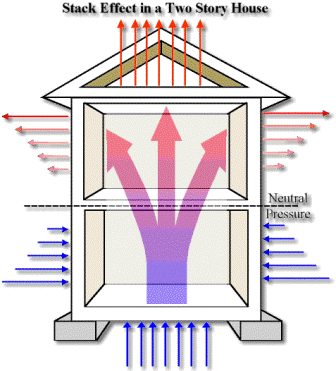 Within everyone's homes are different pressures. You can't feel them but they are there. The upper portion of a home is under a positive pressure with air trying to get out and the lower portion of the home is under a negative pressure with air trying to get in. Somewhere in the middle is the neutral pressure zone where air isn't trying to get in or out. So the higher you go, the stronger the positive pressure. The lower you go, the stronger the negative pressure. It is this negative pressure, that pulls radon into our homes. The greater the temperature differential between the inside of our homes and the temperature outside our homes, the greater the pressures become. So radon levels are usually higher in the winter, then summer with spring and fall being the lowest.
Within everyone's homes are different pressures. You can't feel them but they are there. The upper portion of a home is under a positive pressure with air trying to get out and the lower portion of the home is under a negative pressure with air trying to get in. Somewhere in the middle is the neutral pressure zone where air isn't trying to get in or out. So the higher you go, the stronger the positive pressure. The lower you go, the stronger the negative pressure. It is this negative pressure, that pulls radon into our homes. The greater the temperature differential between the inside of our homes and the temperature outside our homes, the greater the pressures become. So radon levels are usually higher in the winter, then summer with spring and fall being the lowest. The Bad News
Last year in America, over 21,000 of our loved ones died from cancer caused by radon. Our country spent over 2 Billion dollars in health care costs due to radon exposure and sadly, this year it will happen again because most people still do not know that radon has been linked to over 12% of all cancer deaths. Our State and Federal governments are trying everything they can to educate and inform all of us about radon but they simply do not have the proper funding to get the message out. An increase in the radon awareness budget does not seem likely anytime in the near future.
The Good News
All the information you need to know about radon is right here and it only takes about 15 minutes to learn the facts. Protect your family and become an advocate for radon awareness. We can save thousands of lives every year through a grassroots effort by telling our friends, neighbors and loved ones about radon. Together, we can make a difference.
Protecting Your Family Is Easy... Learn the Facts, Test your Home.
If a Problem is Found, Fix It.
This site is made possible by visitors like you.
Thank you and we appreciate your support!
This site is made possible by visitors like you.
Thank you and we appreciate your support!
